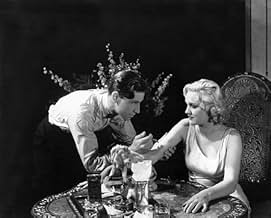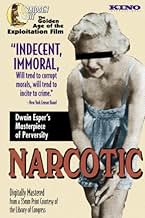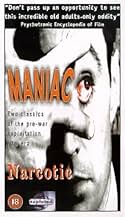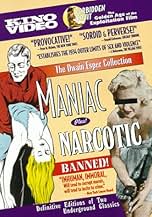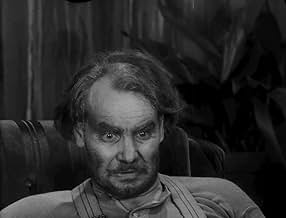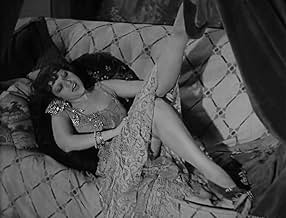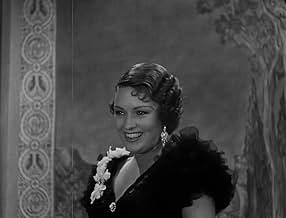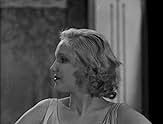Film d'exploitation qui suit la spirale descendante d'un étudiant en médecine idéaliste dont la déchéance le conduit dans des fumeries d'opium, un spectacle de monstres de foire, des fêtes d... Tout lireFilm d'exploitation qui suit la spirale descendante d'un étudiant en médecine idéaliste dont la déchéance le conduit dans des fumeries d'opium, un spectacle de monstres de foire, des fêtes de la drogue huppées, et bordels miteux.Film d'exploitation qui suit la spirale descendante d'un étudiant en médecine idéaliste dont la déchéance le conduit dans des fumeries d'opium, un spectacle de monstres de foire, des fêtes de la drogue huppées, et bordels miteux.
- Réalisation
- Scénario
- Casting principal
Herman Hack
- Burger
- (non crédité)
Celia McCann
- Prostitute
- (non crédité)
Elmer McCurdy
- Self
- (non crédité)
Fred Parker
- Policeman
- (non crédité)
Philip Sleeman
- Drug Addict
- (non crédité)
Blackie Whiteford
- Dennison
- (non crédité)
Avis à la une
Another "message" film by Dwain Esper, also written by his wife, Hildegarde Stadie, as was Maniac. It is an example of pre-code Hollywood, and has a place in film history. The message, is, of course, about the evils of drugs.
It is interesting that the Asian in the film was play by a Caucasian, none other than J. Stuart Blackton Jr., who, along with D.W. Griffith, was a pioneer in the development of the motion picture art.
The film also features Jean Lacy, who as Jeanne Gray, had her own talk show on TV from 1949-51. She didn't like the way the young announcer introduced her, "And Nowww, Thhhe . . . Jeeeeannne . . . Graaaay . . . " Thayoung announcer, who wanted his own show, was none other than Johnny Carson.
At least it wasn't as silly as Reefer Madness.
It is interesting that the Asian in the film was play by a Caucasian, none other than J. Stuart Blackton Jr., who, along with D.W. Griffith, was a pioneer in the development of the motion picture art.
The film also features Jean Lacy, who as Jeanne Gray, had her own talk show on TV from 1949-51. She didn't like the way the young announcer introduced her, "And Nowww, Thhhe . . . Jeeeeannne . . . Graaaay . . . " Thayoung announcer, who wanted his own show, was none other than Johnny Carson.
At least it wasn't as silly as Reefer Madness.
This is a movie that I found when looking for horror from 1933. The title intrigued me as I didn't know if we would be getting like an early drug dealing movie or what. I came into this one blind aside from knowing the year and that it was in genre. I did notice Harry Cording starred, which I just saw him in another movie from the same year as well.
Synopsis: exploration film which follows the downward spiral of an idealistic medical student whose fall from grace leads him to opium dens, a carnival freakshow, swanky drug parties, dingy brothels and finally a realization of his decisions.
Now I'll admit, I did clean up the synopsis a bit as it spoiled the ending. This is an early propaganda film to prevent drug addiction. It warns us with opening text that the medical student from the synopsis becomes a successful snake oil salesman. His name is Dr. William G. Davis (Cording). This is also supposedly based in fact. Upon watching it, I'm sure there are plot points here that mirror real people or things that did happen.
We see William when he is still a med student. He hangs out with a few guys and one is Gee Wu (J. Stuart Blackton Jr.). This is a racist take on someone from Asian and he introduces William to an opium den. What I find interesting here is that we get a look at American and western culture. Gee states that in Asia, they're able to use opium recreationally and not become fully addicted. There are those that do, but for the most part they can use it as a release. In America, they get hooked and this is warning the viewer to stay away from these dens. Also that Americans push to the excess more easily.
It is from here that William becomes addicted. He doesn't think he is and that he can stop whenever. There is a vibe here of 'The Strange Case of Dr. Jekyll and Mr. Hyde' with William working in a free clinic. He doesn't make a lot of money though. He is striving to buy a gold locket but can't afford it. He gets the idea to use opium to create a tonic and watching a peddler makes him realize he needs to find the right way to market it. This isn't far from the truth before regulations prevented putting things like this freely in items.
Without going through each of the points from the synopsis again, William is hurt in a car accident and that gets him hooked back on opium. The driver that crashes with him in the vehicle is also an addict. William lives an interesting life with a circus and scores dope with a guy there. He also hangs out with the likes of Lena (Jean Lacy), Mae (Patricia Farley) and her friends as they use different things as well. It also shows us the effects of living life this way.
That is where I'll leave my recap and introduction to the story. Where I want to start is the tone here. This is absolutely a propaganda film a la Reefer Madness. What I'll give credit here is that I've seen the effects heroin has on people so this is much closer. I didn't bring up that there is a couple more texts screens that we get, one stating that the drug party we see is something that most don't get to. We are able to due to people getting clean and relaying what they experienced. I bring this up as they're using heroin, pills and smoking 'marijuana cigarettes'. This goes heavy handed with its message. At least it is closer to form though.
With that set up, let me get into whether this is horror or not. It isn't in the traditional sense. We don't get murders or monsters or anything to this effect. What we do though is see is more the horrors of humanity and our decisions. The 'horror' is drug addiction here. What is interesting is that this movie portrays it as fun. That is until the 'bill comes due' and you must pay. What I'll say is that it doesn't end well for William. Do not come into this expecting horror as we know it today. This is a cautionary tale.
There isn't more to go into the story for me so I'll go to the acting. This isn't good either. It is stiff. I'm not going to go through each person to see if they acted after or even before this. I do think that Cording is fine as our lead. We see him go through a lot of things and that works. Other than that, Joan Dix, Farley, Lacy and the rest of the cast are fine. It can be stiff and I don't know if this does the best at conveying the effects of what they're doing. The gravity is there, but it comes off comical to me. I did want to give credit to Blackton. It is racist to have him playing this character. I do like what they gave him to work with though. This is a western way of looking at things though as well.
All that is left then would be the filmmaking. I don't think this is particularly strong either. The cinematography is fine. The different set pieces we see are good. It is an interesting path that William goes along. The message is too heavy handed though to the point were watching it today made me laugh. We don't get a lot in the way of effects, but this feels more like a docu-drama than a movie so that is part of it. The soundtrack also didn't stand out or hurt this either.
In conclusion, this isn't a good movie. I think there is a good message this wants to convey, but it doesn't translate as well for modern viewers. It might have been for the 1930s. The acting is stiff. Cording and Blackton being the two best performances despite my issue with the casting of the latter. The filmmaking is fine. It is lacking there. This also isn't horror in the traditional sense either. It is more of a cautionary tale for sure. I can't recommend this unless you want to laugh at what this tries to do.
My Rating: 4.5 out of 10.
Synopsis: exploration film which follows the downward spiral of an idealistic medical student whose fall from grace leads him to opium dens, a carnival freakshow, swanky drug parties, dingy brothels and finally a realization of his decisions.
Now I'll admit, I did clean up the synopsis a bit as it spoiled the ending. This is an early propaganda film to prevent drug addiction. It warns us with opening text that the medical student from the synopsis becomes a successful snake oil salesman. His name is Dr. William G. Davis (Cording). This is also supposedly based in fact. Upon watching it, I'm sure there are plot points here that mirror real people or things that did happen.
We see William when he is still a med student. He hangs out with a few guys and one is Gee Wu (J. Stuart Blackton Jr.). This is a racist take on someone from Asian and he introduces William to an opium den. What I find interesting here is that we get a look at American and western culture. Gee states that in Asia, they're able to use opium recreationally and not become fully addicted. There are those that do, but for the most part they can use it as a release. In America, they get hooked and this is warning the viewer to stay away from these dens. Also that Americans push to the excess more easily.
It is from here that William becomes addicted. He doesn't think he is and that he can stop whenever. There is a vibe here of 'The Strange Case of Dr. Jekyll and Mr. Hyde' with William working in a free clinic. He doesn't make a lot of money though. He is striving to buy a gold locket but can't afford it. He gets the idea to use opium to create a tonic and watching a peddler makes him realize he needs to find the right way to market it. This isn't far from the truth before regulations prevented putting things like this freely in items.
Without going through each of the points from the synopsis again, William is hurt in a car accident and that gets him hooked back on opium. The driver that crashes with him in the vehicle is also an addict. William lives an interesting life with a circus and scores dope with a guy there. He also hangs out with the likes of Lena (Jean Lacy), Mae (Patricia Farley) and her friends as they use different things as well. It also shows us the effects of living life this way.
That is where I'll leave my recap and introduction to the story. Where I want to start is the tone here. This is absolutely a propaganda film a la Reefer Madness. What I'll give credit here is that I've seen the effects heroin has on people so this is much closer. I didn't bring up that there is a couple more texts screens that we get, one stating that the drug party we see is something that most don't get to. We are able to due to people getting clean and relaying what they experienced. I bring this up as they're using heroin, pills and smoking 'marijuana cigarettes'. This goes heavy handed with its message. At least it is closer to form though.
With that set up, let me get into whether this is horror or not. It isn't in the traditional sense. We don't get murders or monsters or anything to this effect. What we do though is see is more the horrors of humanity and our decisions. The 'horror' is drug addiction here. What is interesting is that this movie portrays it as fun. That is until the 'bill comes due' and you must pay. What I'll say is that it doesn't end well for William. Do not come into this expecting horror as we know it today. This is a cautionary tale.
There isn't more to go into the story for me so I'll go to the acting. This isn't good either. It is stiff. I'm not going to go through each person to see if they acted after or even before this. I do think that Cording is fine as our lead. We see him go through a lot of things and that works. Other than that, Joan Dix, Farley, Lacy and the rest of the cast are fine. It can be stiff and I don't know if this does the best at conveying the effects of what they're doing. The gravity is there, but it comes off comical to me. I did want to give credit to Blackton. It is racist to have him playing this character. I do like what they gave him to work with though. This is a western way of looking at things though as well.
All that is left then would be the filmmaking. I don't think this is particularly strong either. The cinematography is fine. The different set pieces we see are good. It is an interesting path that William goes along. The message is too heavy handed though to the point were watching it today made me laugh. We don't get a lot in the way of effects, but this feels more like a docu-drama than a movie so that is part of it. The soundtrack also didn't stand out or hurt this either.
In conclusion, this isn't a good movie. I think there is a good message this wants to convey, but it doesn't translate as well for modern viewers. It might have been for the 1930s. The acting is stiff. Cording and Blackton being the two best performances despite my issue with the casting of the latter. The filmmaking is fine. It is lacking there. This also isn't horror in the traditional sense either. It is more of a cautionary tale for sure. I can't recommend this unless you want to laugh at what this tries to do.
My Rating: 4.5 out of 10.
Watching Narcotic as a film for its own sake--as an artwork or a piece of entertainment, that is--at this point in time is not entirely satisfactory. For one, it's very choppy. Scenes are missing or truncated oddly, but this is the best print known at the moment. But even if the missing footage were replaced, the film is still uneven. Director Dwain Esper and his wife, writer Hildegarde Stadie, have a bizarre sense of dramatic construction only rivaled by Ed Wood. Esper inserts odd shots for symbolism (such as poisonous snakes, skunks and such near the end), inserts odd intertitles at odd times, and so on. And a lot of the performances intermittently go off the rails. Yet as a historical and sociological oddity, Narcotic is fascinating. Any film buff worth his or her weight in Fassbinder posters should be familiar with it, as should anyone interested in sociology or cultural theory.
I'm not sure if this is the first paranoid anti-drug film, but it must be one of the earlier ones. It beat Esper's similar and more famous Reefer Madness by three years. Additionally, this is much broader in scope than that later film. It's not quite as black and white or ridiculously propagandistic, and it's supposedly based on a true story--a real equivalent to Dr. William G. Davis (played here by Harry Cording), who went on the road hawking "Tiger Fat" (a name only mentioned in intertitles here as far as I could tell), and who was a drug addict stuck in a depressing downward spiral.
The content, which focuses on explicit drug use (including scenes of drug preparation), violence--both accidental and intentional--that remains morally unrectified, serious relationship problems, drug-induced and illicit sexual behavior, and a fantastic, nihilistic ending, may sound like a perfect recipe for a Cheech and Chong film, but in 1933, it was all very challenging. So challenging that the film was rejected twice (once on appeal) by the New York State Film Board. Documentation about this is an interesting special feature on the Kino DVD.
I certainly do not agree with censorship, but the New York State Film Board was astute in some of its criticism of the film. Although viewers could hardly desire ending up like Dr. Davis in the end, many of the scenes are not clearly anti-drug and debauchery. Many scenes seem pro drug and debauchery instead, especially to someone with a hedonistic, libertarian bent, such as myself. They also show basic preparation and administration techniques for drugs.
Although it doesn't seem consistent with their filmographies, Esper and Stadie seem to show pretty explicitly that they're not clearly anti-drug in the comments from "Chinese" character Gee Wu (J. Stuart Blackton, Jr.). Wu presents a pro-opium view early in the film, and through the character, Esper and Stadie suggest that the problem with drugs lies more with cultural differences than in the drugs themselves, even though they seem to backpeddle a bit further into the film.
It's beneficial to keep these kinds of things in mind while watching Narcotic--they'll keep you interested and help stave off Morpheus.
I'm not sure if this is the first paranoid anti-drug film, but it must be one of the earlier ones. It beat Esper's similar and more famous Reefer Madness by three years. Additionally, this is much broader in scope than that later film. It's not quite as black and white or ridiculously propagandistic, and it's supposedly based on a true story--a real equivalent to Dr. William G. Davis (played here by Harry Cording), who went on the road hawking "Tiger Fat" (a name only mentioned in intertitles here as far as I could tell), and who was a drug addict stuck in a depressing downward spiral.
The content, which focuses on explicit drug use (including scenes of drug preparation), violence--both accidental and intentional--that remains morally unrectified, serious relationship problems, drug-induced and illicit sexual behavior, and a fantastic, nihilistic ending, may sound like a perfect recipe for a Cheech and Chong film, but in 1933, it was all very challenging. So challenging that the film was rejected twice (once on appeal) by the New York State Film Board. Documentation about this is an interesting special feature on the Kino DVD.
I certainly do not agree with censorship, but the New York State Film Board was astute in some of its criticism of the film. Although viewers could hardly desire ending up like Dr. Davis in the end, many of the scenes are not clearly anti-drug and debauchery. Many scenes seem pro drug and debauchery instead, especially to someone with a hedonistic, libertarian bent, such as myself. They also show basic preparation and administration techniques for drugs.
Although it doesn't seem consistent with their filmographies, Esper and Stadie seem to show pretty explicitly that they're not clearly anti-drug in the comments from "Chinese" character Gee Wu (J. Stuart Blackton, Jr.). Wu presents a pro-opium view early in the film, and through the character, Esper and Stadie suggest that the problem with drugs lies more with cultural differences than in the drugs themselves, even though they seem to backpeddle a bit further into the film.
It's beneficial to keep these kinds of things in mind while watching Narcotic--they'll keep you interested and help stave off Morpheus.
Of the various low-budget exploitationers of the 1930s, I was only familiar with the similarly drug-related TELL YOUR CHILDREN (1938), better-known by its alternate title REEFER MADNESS – actually produced by Dwain Esper, the co-director of this one and a film-maker whose notorious reputation (for lack of talent) rivals that of Ed Wood himself! Here, then, we ostensibly have the case history (cue exhaustive exposition in the form of title cards) of a doctor who indulged in various types of drugs, starting out with opium (suggested by the stereotypical wise-yet-evil Chinese) but soon progressing to heroin
all of which ends with him losing everything (living in a two-bit dive and eventually turning a gun on himself!). While I was expecting horrific hallucinations or (unintentionally hilarious) hyperbolic reactions resulting from the intake of drugs, all one got is an excess of dull talk which quickly exasperated this viewer long before the film's brief 57 minutes were up! Still, there were at least three scenes which have to be seen to be believed: a chauffeur popping pills while driving gets his car smashed by an oncoming train; the lengthy "drug party" itself with the participants freely sniffing coke and injecting heroin while dancing and bickering amongst themselves; and a completely irrelevant bit (obviously stock footage) of a couple of snakes fighting capped by the victor literally swallowing up the defeated reptile!
Someone who only knows of Esper, coming to this film with n open mind will I think be rather surprised at how good it is. Far from being a mindless hack who churned out any oddly rubbish for the so-called "exploitation" market, Esper very clearly had aspirations of an artistic kind and experiments with European-style montage (not simply "irrelevant footage" as one reviewer seems to think), very rare in US film, and with some interesting chiaroscuro effects. This sometimes makes the continuity a little dodgy but gives the film a certain quality much superior to the general run of "Poverty Row" films.
By contrast, his follow-up, Maniac, which dabbles in horror/melodrama somewhat in the line of the contemporary British star Tod Slaughter, is not nearly so good a film and gives a yardstick by which to appreciate the real qualities of Narcotic.
What one also sees most clearly with Esper at his best is the way in which the "exploitation" film is really a sort of alter ego, a shameful double of the US industry as a whole. Consider for instance how a typical police-operation gangster film uses essentially the same tropes - one part of the film follows the police or the FBI (emphasising the evil of the gangsterism in narrations that are not unlike Esper's supposedly didactic intertitles, while the other part of the film allows the viewer to enjoy the antics of the gangster.
Genre after genre in US cinema in fact exhibit the same essential traits as the "exploitation" film because it is what, between censorship rules and greed for high profits, the US film industry had essentially learned to be and Esper's films are simply a microcosm, Hollywood denuded of its glamour.
Note two how this film is interestingly rooted in the memory of Hollywood with silent stars Paul Panzer and Josef Swickard and even the son of film pioneer Stuart Blackton amongst the cast.
By contrast, his follow-up, Maniac, which dabbles in horror/melodrama somewhat in the line of the contemporary British star Tod Slaughter, is not nearly so good a film and gives a yardstick by which to appreciate the real qualities of Narcotic.
What one also sees most clearly with Esper at his best is the way in which the "exploitation" film is really a sort of alter ego, a shameful double of the US industry as a whole. Consider for instance how a typical police-operation gangster film uses essentially the same tropes - one part of the film follows the police or the FBI (emphasising the evil of the gangsterism in narrations that are not unlike Esper's supposedly didactic intertitles, while the other part of the film allows the viewer to enjoy the antics of the gangster.
Genre after genre in US cinema in fact exhibit the same essential traits as the "exploitation" film because it is what, between censorship rules and greed for high profits, the US film industry had essentially learned to be and Esper's films are simply a microcosm, Hollywood denuded of its glamour.
Note two how this film is interestingly rooted in the memory of Hollywood with silent stars Paul Panzer and Josef Swickard and even the son of film pioneer Stuart Blackton amongst the cast.
Le saviez-vous
- AnecdotesThe film includes an appearance of Elmer McCurdy, an Oklahoma would-be bank robber who was killed in 1911, and whose embalmed body circulated through various sideshows, fun houses and amusement parks for over 60 years. McCurdy's body was not only used as that of a "drug addict" in the film but was put on display by Dwain Esper at screenings of the movie. McCurdy was eventually discovered in a Long Beach (CA) funhouse in 1977 by a film crew for the TV series L'homme qui valait 3 milliards (1974) and he was returned to Oklahoma for proper burial.
- GaffesWhen Davies is persuading his wife that his plan will work, the boom shadow falls the wall behind them. Also, the mike dips briefly into the shot and, and the camera moves forward, the shadow of the accordion-style apparatus used to hoist the mike is also visible, almost distractingly so, on the wall, right behind the wife.
- ConnexionsFeatured in Narcotic Dens of the Orient (1953)
Meilleurs choix
Connectez-vous pour évaluer et suivre la liste de favoris afin de recevoir des recommandations personnalisées
Détails
Box-office
- Budget
- 8 900 $US (estimé)
- Durée57 minutes
- Couleur
- Mixage
- Rapport de forme
- 1.37 : 1
Contribuer à cette page
Suggérer une modification ou ajouter du contenu manquant


